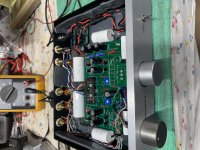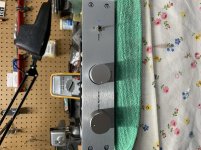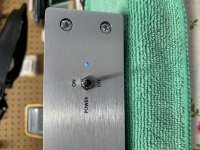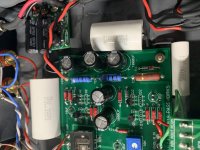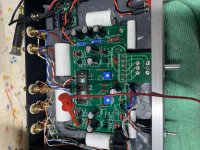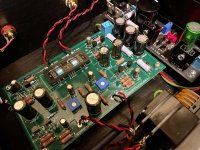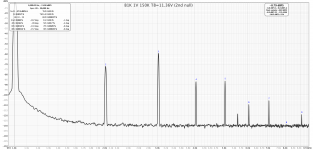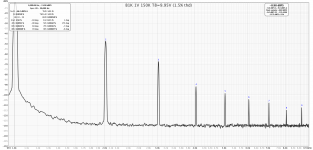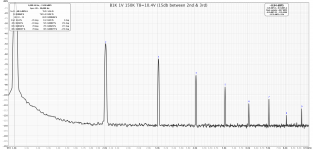Dear Auddy,
I plugged my new B1 Korg into the ACA monoblocs in my wife’s art studio temporarily, just while I was finishing up an M2x. Now she won’t let me take back the B1K for my setup! She calls it all “warm and full” sounding. What am I supposed to do now?
Signed,
Korgless in Texas 😀
I plugged my new B1 Korg into the ACA monoblocs in my wife’s art studio temporarily, just while I was finishing up an M2x. Now she won’t let me take back the B1K for my setup! She calls it all “warm and full” sounding. What am I supposed to do now?
Signed,
Korgless in Texas 😀
Dear Auddy,
I plugged my new B1 Korg into the ACA monoblocs in my wife’s art studio temporarily, just while I was finishing up an M2x. Now she won’t let me take back the B1K for my setup! She calls it all “warm and full” sounding. What am I supposed to do now?
Signed,
Korgless in Texas 😀
You're screwed, but I gather the full kit is in stock at DIYAudio Store



Dear Korgless,Dear Auddy,
I plugged my new B1 Korg into the ACA monoblocs in my wife’s art studio temporarily, just while I was finishing up an M2x. Now she won’t let me take back the B1K for my setup! She calls it all “warm and full” sounding. What am I supposed to do now?
Signed,
Korgless in Texas 😀
 Looks like you'll be building another one for yourself to keep the peace.
Looks like you'll be building another one for yourself to keep the peace.It could be worse. Your wife could have confiscated your B1K while no kits were in stock. Better hurry before they're on backorder again
You're gonna love it with M2x BTW.

Nice synergy those two amps. Just like your relationship when you build a second one.

Have fun,
Auddy
I suggest whilst you are at it, get a PO89ZB and put that in too, but do NOT let the wife listen or it will be even "warmer and fuller"
Just finished my Korg. 😀
All voltages are good and adjusted to 9.5v
Is there anything else I should be checking ?
All voltages are good and adjusted to 9.5v
Is there anything else I should be checking ?
Attachments
Just finished my Korg. 😀
All voltages are good and adjusted to 9.5v
Is there anything else I should be checking ?
I see you did not apply any anti-vibration materials to dampen microphonics. I'd reconsider that. Also when you first fire it up, keep your finger on the volume control because the microphonics are a form of feedback which can grow out of control (loud) pretty quickly. Turn things up slowly, test on different material, rinse and repeat until you've convinced yourself that at reasonable listening levels all is well.
Next, I seen that you've settled on 9.5v for the bias setting. I'd really encourage you to play around with the settings both above and below that while doing some listening tests. The holographic results are really striking while at the same time will really show you the practical affects. You never know, you might like 8.5v or 10v - depends on your personal setup, situation and preferences but thats half the magic of the DIY!
--Tom
Before I buttoned it up I put the eraser on the tube, but I just set it there.
Should I use some type of adhesive ?
I have lined the case with "duct seal" to help deaden the box.
Music sounds great so far. Tried different music and all different volume levels with no ringing at all.
The only time I get "ringing" is when I switch sources and even then it only lasts for about 3-5 seconds. Is there anything I can do to prevent this ?
Should I use some type of adhesive ?
I have lined the case with "duct seal" to help deaden the box.
Music sounds great so far. Tried different music and all different volume levels with no ringing at all.
The only time I get "ringing" is when I switch sources and even then it only lasts for about 3-5 seconds. Is there anything I can do to prevent this ?
Stop switching sources ;-)
OK, OK...perhaps try to see if it is the cables that transmit the bad vibs from the selector or if it is the casing that transmits to the PCB.
I had a problem on the bench with a plastic on/off power switch, something I expected to be no issue and if ever then less brutal than the traditional metal toggle switches. I was wrong, made the Korg vibrate each time for a few sec, whereas the toggle switch helped getting rid of that... and it was just the power switch. Transmitted bad vibs through the tiny power cables.
Be it cables or casing, both can be damped... try putting your finger on either when selecting sources to see what affects what...
I hope this helps
Claude
PS: nice caps, neat fitting ;-)
OK, OK...perhaps try to see if it is the cables that transmit the bad vibs from the selector or if it is the casing that transmits to the PCB.
I had a problem on the bench with a plastic on/off power switch, something I expected to be no issue and if ever then less brutal than the traditional metal toggle switches. I was wrong, made the Korg vibrate each time for a few sec, whereas the toggle switch helped getting rid of that... and it was just the power switch. Transmitted bad vibs through the tiny power cables.
Be it cables or casing, both can be damped... try putting your finger on either when selecting sources to see what affects what...
I hope this helps
Claude
PS: nice caps, neat fitting ;-)
Last edited:
Before I buttoned it up I put the eraser on the tube, but I just set it there.
Should I use some type of adhesive ?
I have lined the case with "duct seal" to help deaden the box.
Music sounds great so far. Tried different music and all different volume levels with no ringing at all.
The only time I get "ringing" is when I switch sources and even then it only lasts for about 3-5 seconds. Is there anything I can do to prevent this ?
That sounds similar to what I was experiencing - the board is coupled to the chassis. My chassis and amp are located a couple of feet from the speakers in my office. When you flip the switch, it vibrates the chassis, and in turn the circuit board and in turn the NuTube. Any vibrations induced into the chassis seem to be able to excite the NuTube, at least certain runs of it. The NuTube itself is physically coupled to the main board being soldered directly to it, and that board to the chassis via the stand-offs. The only way I was able to dampen the microphonics completely was through a combination of padding both above and below the NuTube as well as replacing the solid metal standoffs with the rubber ones I mentioned in a post above.
--Tom
I do have some of the rubber stand-off's coming so I will try that for sure.
How should I secure the eraser to the tube ?
How should I secure the eraser to the tube ?
I do have some of the rubber stand-off's coming so I will try that for sure.
How should I secure the eraser to the tube ?
To test it, painter's tape seems best so you can remote it. I used
use liquid silicone when you are satisfied and want a more permanent option, but 2-sided tape works too. Others have used foam that has sticky tape on one or both sides (i.e.: like door/window gasket foam).
--Tom
I have the window seal foam between the board and the tube now
"Be it cables or casing, both can be damped"
How would i dampen the cables ?
"Be it cables or casing, both can be damped"
How would i dampen the cables ?
I have the window seal foam between the board and the tube now
"Be it cables or casing, both can be damped"
How would i dampen the cables ?
I had no issues once I isolated the NuTube and main board (i.e.: did not have to dampen anything else).
--Tom
Just finished my Korg. 😀
All voltages are good and adjusted to 9.5v
Is there anything else I should be checking ?
Congratulations Rtate enjoy the music
what checking..well the sound..
I am curious about reverse speakers phase effect
and after week or two maybe do simple experiment
and bypass all polypros caps with polarised 10uF Silmic II..
do You like it better bass without or with ?
Some extract from B1K article 🙂 Have fun
Attachments
Damping cables... here we go...
You could try less rigid cables, or you could also have the existing ones arranged so that they don't form a straight line, or you could put weight or damping material on it (blu tack works great)
I hope this helps
Claude
You could try less rigid cables, or you could also have the existing ones arranged so that they don't form a straight line, or you could put weight or damping material on it (blu tack works great)
I hope this helps
Claude
Damping cables... here we go...
You could try less rigid cables, or you could also have the existing ones arranged so that they don't form a straight line, or you could put weight or damping material on it (blu tack works great)
I hope this helps
Claude
Try these to secure cable runs down. I use them all the time.
https://www.amazon.com/GWHOLE-100Pc...words=3m+car+cable+clip&qid=1612828038&sr=8-1
--Tom
I finally got around to building the B1K. I'm really impressed! Most of my other preamp builds are in the .0X-.00X% thd range, so I was expecting the 1.5% B1K to be over the top. Not so. I played around with a few different distortion levels, but keep coming back to Nelson's prescribed settings (go figure 😀) I started out using the standard wallwart, but did see a noticeable improvement when I swapped it out for the Salas UltraBiB.
Attached are a few measurements – details are at top of images.
Attached are a few measurements – details are at top of images.
Attachments
ok, so I have a question about the coupling film cap "break-in"
Can I just leave the preamp on for 100 hours or so to burn the caps in or do I have to have a source in putting a signal the entire time ?
Do I need the output connected as well ?
I could just leave a cd on repeat for days with the amp turned off if that would work ?
Can I just leave the preamp on for 100 hours or so to burn the caps in or do I have to have a source in putting a signal the entire time ?
Do I need the output connected as well ?
I could just leave a cd on repeat for days with the amp turned off if that would work ?
ok, so I have a question about the coupling film cap "break-in"
Can I just leave the preamp on for 100 hours or so to burn the caps in or do I have to have a source in putting a signal the entire time ?
Do I need the output connected as well ?
I could just leave a cd on repeat for days with the amp turned off if that would work ?
Honestly, if you probably just left it on (no signal) and connected to an amp you could probably break them in that way. If it's a film cap, likely less break in needed than an electrolytic. Or at least, less change in sound. There are some capacitor "break-in" devices that simply deliver AC through the cap and the voltage does not vary. So, it would be similar to this.
- Home
- Amplifiers
- Pass Labs
- B1 with Korg Triode
